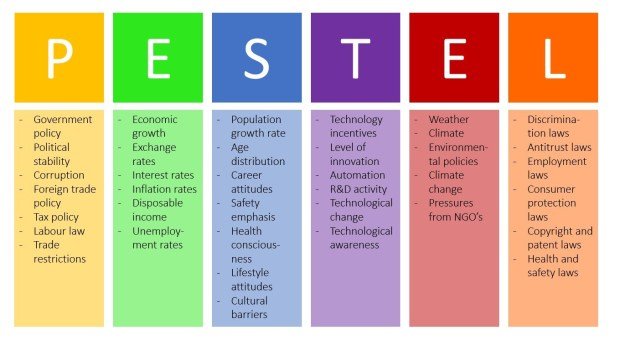External environment analysis is an important part of strategic management.
PESTEL Analysis
PESTEL analysis includes Political, Economic, Social, Technological, Environmental and Legal analysis. It is an external environment analysis for conducting a strategic analysis or carrying out market research. It offers a certain overview of the varied macro-environmental factors that the company has to consider.

-
Political factors
Political factors analysis is related with how and to what extent a government interferes in the economy. Specifically, political factors include tax policy, labor law, environmental law, trade restrictions, tariffs, and political stability. Political factors may also be related with goods and services which the government allows (merit goods) and those that the government does not want to allow (demerit goods). The government can have a great influence on the overall health, education, and infrastructure of a country.
-
Economic factors
Economic factors contain factors such as economic growth, interest rates, exchange rates and the inflation rate. These factors may have an influential effect on how the businesses operate and make decisions. For example, interest rates can affect the firm’s cost of capital and thereby influence business growth and expansion. Exchange rates can affect the costs of export and the supply and price of imports.
-
Social factors
Social factors contain issues such as health consciousness, population growth rate, age distribution, career attitudes and emphasis on safety. Trends in the social factors may affect the demand for a company’s goods and how the company operates. For example, ageing population leads to smaller and less-willing workforce (and increases the cost of labor). Moreover, companies may change various management strategies in sync with the social trends (such as recruiting more females).
-
Technological factors
Technological factors include ecological and environmental aspects, such as R&D activity, automation, technology incentives and the rate of technological change. They can determine barriers to entry, minimum efficient production level and influence outsourcing decisions. Furthermore, technological shifts can affect costs, quality, and lead to innovation.
-
Environmental factors
Environmental factors are the conditions such as weather, climate, and climate change, which may especially influence tourism, farming, and insurance sectors. Growing awareness to climate change are increasing the interest in how companies operate and what products they offer; it is both creating new markets and damaging the existing ones.
-
Legal factors
Legal factors include laws pertaining to discrimination, consumer affairs, antitrust, employment, and health and safety. These factors can affect the operations, costs, and the demand for the products. Legal factors can also influence the brand value and reputation of a company. They are increasingly paid more attention to in the current decade.
While in external analysis, three correlated environment should be studied and analyzed:
- Immediate / industry environment
- National environment
- Broader socio-economic environment / macro-environment
Examining the industry environment needs an appraisal of the competitive structure of the organization’s industry, including the competitive position of a particular organization and it’s main rivals. Also, an assessment of the nature, stage, dynamics and history of the industry is essential. It also implies evaluating the effect of globalization on competition within the industry. Analyzing the national environment needs an appraisal of whether the national framework helps in achieving competitive advantage in the globalized environment. Analysis of macro-environment includes exploring macro-economic, social, government, legal, technological and international factors that may influence the environment. The analysis of organization’s external environment reveals opportunities and threats for an organization.
Strategic managers must not only recognize the present state of the environment and their industry but also be able to predict its future positions.
One thought on “External considerations including: Social, Economic, Competition and Technological”